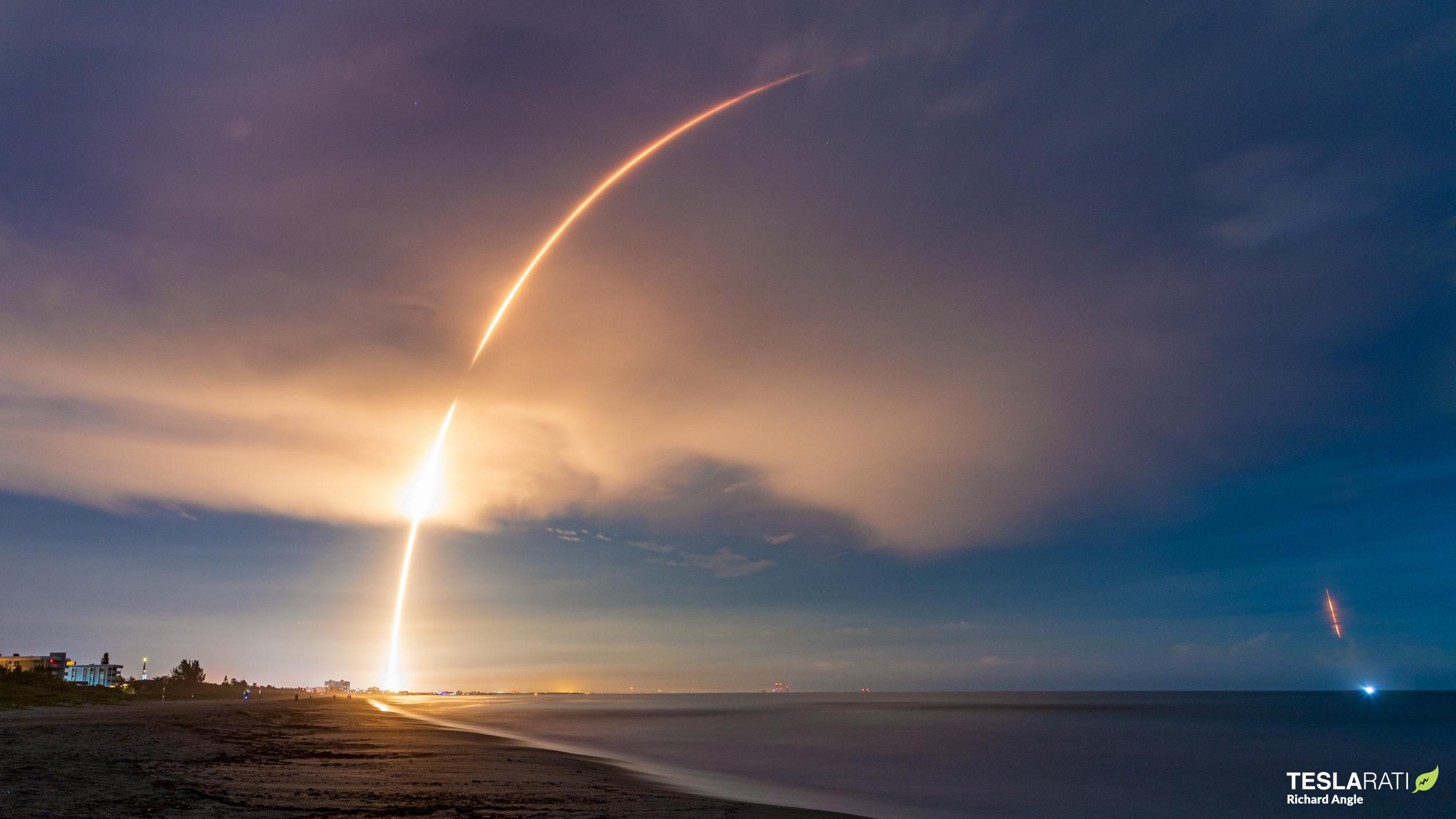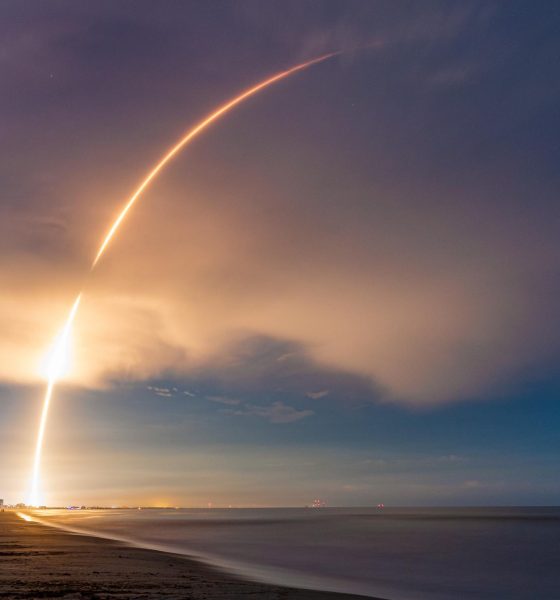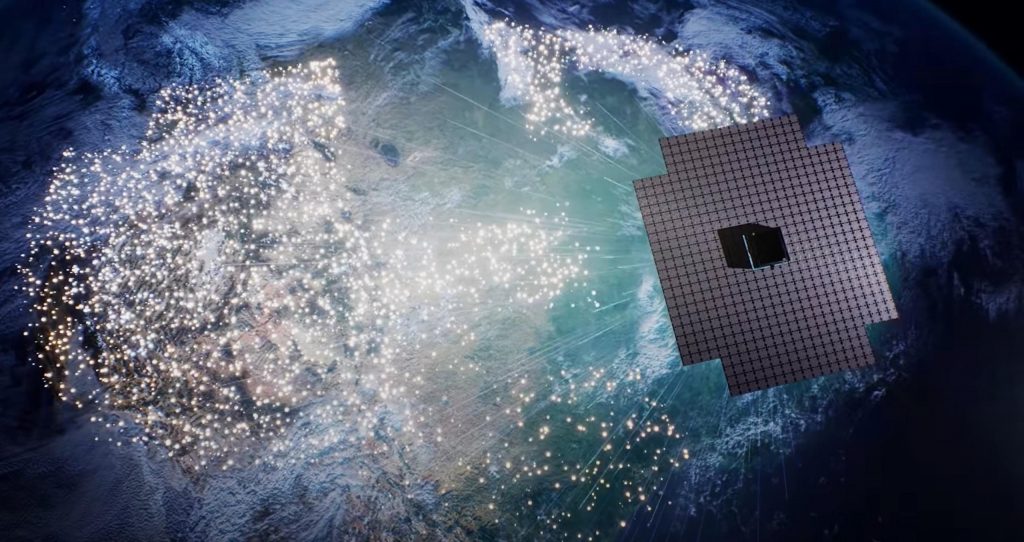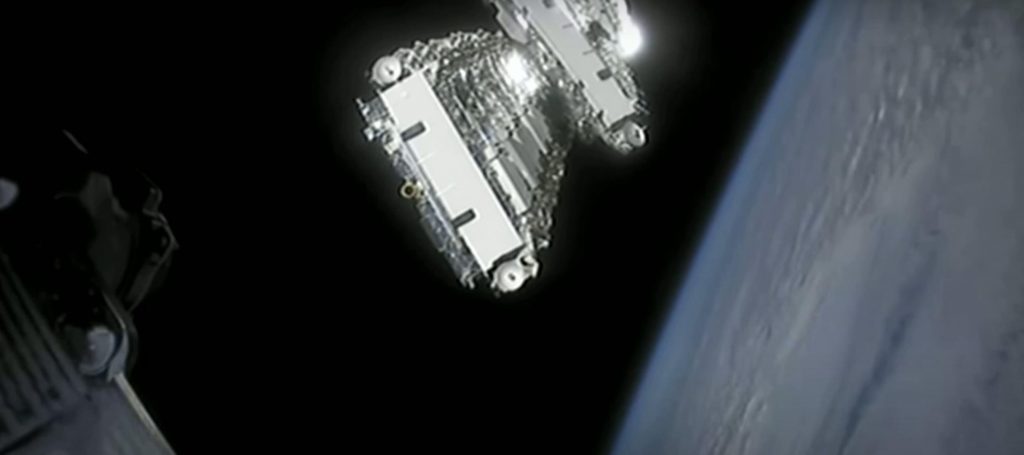

News
SpaceX launches 52nd Falcon 9 rocket in 52 weeks
SpaceX has completed its 52nd successful Falcon 9 launch in 52 weeks, sustaining an average cadence of one launch per week for a full 12 months.
Simultaneously, the Starlink 4-2 rideshare mission set a new record for Falcon 9 booster reuse, marked SpaceX’s 150th consecutively successful launch, and was one of the most complex commercial launches it has ever performed.
In addition to 34 new Starlink V1.5 satellites that joined almost 3000 other working SpaceX spacecraft in orbit, Starlink 4-2 deployed the company’s largest rideshare payload yet – AST SpaceMobile’s 1.5-ton (~3300 lb) BlueWalker 3 communications satellite.
Falcon 9 lifted off on schedule with the combined 12-ton (~26,500 lb) payload safely secured inside its composite payload fairing at 9:20 pm EDT (01:20 UTC) on Saturday, September 10th. Tasked with lifting the rocket’s expendable upper stage, recoverable fairing, and payload most of the way out of Earth’s atmosphere was Falcon 9 booster B1058, a nine-engine first stage that debuted by launching two NASA astronauts in May 2020.
28 months later, B1058 lifted off with Starlink 4-2 and BlueWalker 3 on its 14th spaceflight and orbital-class launch, breaking Falcon 9’s booster reuse record. The rocket performed no differently than it had every time previously, burning for a bit less than three minutes before deploying the upper stage and returning to Earth. About nine minutes after liftoff, B1058 safely touched down on drone ship A Shortfall Of Gravitas (ASOG), likely setting the booster up to break its own record before the end of 2022. With 13 launches already under their belts, boosters B1051 and B1060 will likely follow B1058 past the same 14-flight milestone in the near future.
Once free from the booster, Falcon 9’s expendable upper stage kicked off SpaceX’s most complex commercial launch ever. Measuring about six minutes long, the first and longest burn brought the second stage and payload into an elliptical orbit a few hundred kilometers above Earth’s surface. A second burn followed about 45 minutes after liftoff, raising the low end of that ellipse to deploy BlueWalker 3 into a circular orbit around 500 kilometers (~310 mi). Using a massive antenna, AST SpaceMobile’s first large satellite prototype will eventually attempt to directly communicate with mobile phones to provide a level of connectivity equivalent to 5G/LTE – all from space.
Once free of its rideshare payload, the focus shifted to Starlink. In theory, SpaceX could have taken the easy way out and significantly simplified the mission by deploying all 34 satellites at the same altitude as BlueWalker 3, simultaneously allowing them to reach their operational 540-kilometer (~336 mi) orbits in days instead of months. Instead, SpaceX pursued an exceptionally complex mission requiring five burns from Falcon 9’s upper stage.
After deploying BlueWalker 3, Falcon 9 S2 lowered one end of its orbit at around T+67 minutes, followed by a fourth burn to lower the other end almost two hours after liftoff. The upper stage then spun up end over end and eventually released all 34 Starlink satellites at an altitude of ~335 kilometers (~208 mi), where debris and faulty satellites will take days – rather than years – to reenter Earth’s atmosphere and burn up.


While SpaceX doesn’t confirm post-payload operations, Falcon 9 S2 was also scheduled to perform a fifth and final burn to quickly deorbit itself, ensuring that the mission only produced five pieces of benign debris. At their very low orbits, those five pieces (four ‘tensioning rods’ and the BlueWalker 3 payload adapter) will pose next to no threat to other spacecraft or rockets and should reenter within a few weeks.
Starlink 4-2 was SpaceX’s 52nd successful Falcon 9 launch since September 14th, 2021, meaning that the company has technically already achieved CEO Elon Musk’s goal of 52 launches in one year – albeit not a calendar year. Perhaps even more impressive, the mission was SpaceX’s 150th consecutively successful Falcon launch. No other single rocket (Falcon 9) or rocket family (Falcon) has launched more times in a row without failure.
Finally, Starlink 4-2 was SpaceX’s 42nd launch of 2022. If the company continues its average cadence over the last three months, it could end 2022 having completed more than 60 Falcon launches in one calendar year.

News
Tesla FSD fleet is nearing 7 billion total miles, including 2.5 billion city miles
As can be seen on Tesla’s official FSD webpage, vehicles equipped with the system have now navigated over 6.99 billion miles.

Tesla’s Full Self-Driving (Supervised) fleet is closing in on almost 7 billion total miles driven, as per data posted by the company on its official FSD webpage.
These figures hint at the massive scale of data fueling Tesla’s rapid FSD improvements, which have been quite notable as of late.
FSD mileage milestones
As can be seen on Tesla’s official FSD webpage, vehicles equipped with the system have now navigated over 6.99 billion miles. Tesla owner and avid FSD tester Whole Mars Catalog also shared a screenshot indicating that from the nearly 7 billion miles traveled by the FSD fleet, more than 2.5 billion miles were driven inside cities.
City miles are particularly valuable for complex urban scenarios like unprotected turns, pedestrian interactions, and traffic lights. This is also the difference-maker for FSD, as only complex solutions, such as Waymo’s self-driving taxis, operate similarly on inner-city streets. And even then, incidents such as the San Francisco blackouts have proven challenging for sensor-rich vehicles like Waymos.
Tesla’s data edge
Tesla has a number of advantages in the autonomous vehicle sector, one of which is the size of its fleet and the number of vehicles training FSD on real-world roads. Tesla’s nearly 7 billion FSD miles then allow the company to roll out updates that make its vehicles behave like they are being driven by experienced drivers, even if they are operating on their own.
So notable are Tesla’s improvements to FSD that NVIDIA Director of Robotics Jim Fan, after experiencing FSD v14, noted that the system is the first AI that passes what he described as a “Physical Turing Test.”
“Despite knowing exactly how robot learning works, I still find it magical watching the steering wheel turn by itself. First it feels surreal, next it becomes routine. Then, like the smartphone, taking it away actively hurts. This is how humanity gets rewired and glued to god-like technologies,” Fan wrote in a post on X.
News
Tesla starts showing how FSD will change lives in Europe
Local officials tested the system on narrow country roads and were impressed by FSD’s smooth, human-like driving, with some calling the service a game-changer for everyday life in areas that are far from urban centers.

Tesla has launched Europe’s first public shuttle service using Full Self-Driving (Supervised) in the rural Eifelkreis Bitburg-Prüm region of Germany, demonstrating how the technology can restore independence and mobility for people who struggle with limited transport options.
Local officials tested the system on narrow country roads and were impressed by FSD’s smooth, human-like driving, with some calling the service a game-changer for everyday life in areas that are far from urban centers.
Officials see real impact on rural residents
Arzfeld Mayor Johannes Kuhl and District Administrator Andreas Kruppert personally tested the Tesla shuttle service. This allowed them to see just how well FSD navigated winding lanes and rural roads confidently. Kruppert said, “Autonomous driving sounds like science fiction to many, but we simply see here that it works totally well in rural regions too.” Kuhl, for his part, also noted that FSD “feels like a very experienced driver.”
The pilot complements the area’s “Citizen Bus” program, which provides on-demand rides for elderly residents who can no longer drive themselves. Tesla Europe shared a video of a demonstration of the service, highlighting how FSD gives people their freedom back, even in places where public transport is not as prevalent.
What the Ministry for Economic Affairs and Transport says
Rhineland-Palatinate’s Minister Daniela Schmitt supported the project, praising the collaboration that made this “first of its kind in Europe” possible. As per the ministry, the rural rollout for the service shows FSD’s potential beyond major cities, and it delivers tangible benefits like grocery runs, doctor visits, and social connections for isolated residents.
“Reliable and flexible mobility is especially vital in rural areas. With the launch of a shuttle service using self-driving vehicles (FSD supervised) by Tesla in the Eifelkreis Bitburg-Prüm, an innovative pilot project is now getting underway that complements local community bus services. It is the first project of its kind in Europe.
“The result is a real gain for rural mobility: greater accessibility, more flexibility and tangible benefits for everyday life. A strong signal for innovation, cooperation and future-oriented mobility beyond urban centers,” the ministry wrote in a LinkedIn post.
News
Tesla China quietly posts Robotaxi-related job listing
Tesla China is currently seeking a Low Voltage Electrical Engineer to work on circuit board design for the company’s autonomous vehicles.

Tesla has posted a new job listing in Shanghai explicitly tied to its Robotaxi program, fueling speculation that the company is preparing to launch its dedicated autonomous ride-hailing service in China.
As noted in the listing, Tesla China is currently seeking a Low Voltage Electrical Engineer to work on circuit board design for the company’s autonomous vehicles.
Robotaxi-specific role
The listing, which was shared on social media platform X by industry watcher @tslaming, suggested that Tesla China is looking to fill the role urgently. The job listing itself specifically mentions that the person hired for the role will be working on the Low Voltage Hardware team, which would design the circuit boards that would serve as the nervous system of the Robotaxi.
Key tasks for the role, as indicated in the job listing, include collaboration with PCB layout, firmware, mechanical, program management, and validation teams, among other responsibilities. The role is based in Shanghai.
China Robotaxi launch
China represents a massive potential market for robotaxis, with its dense urban centers and supportive policies in select cities. Tesla has limited permission to roll out FSD in the country, though despite this, its vehicles have been hailed as among the best in the market when it comes to autonomous features. So far, at least, it appears that China supports Tesla’s FSD and Robotaxi rollout.
This was hinted at in November, when Tesla brought the Cybercab to the 8th China International Import Expo (CIIE) in Shanghai, marking the first time that the autonomous two-seater was brought to the Asia-Pacific region. The vehicle, despite not having a release date in China, received a significant amount of interest among the event’s attendees.








